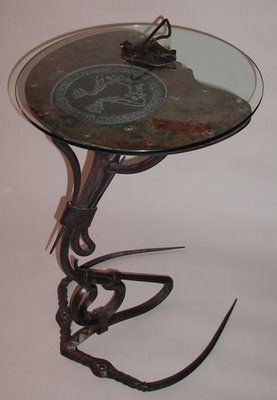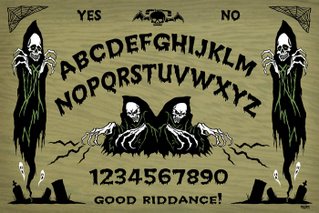Halloweek: The Talking Board
Ouija board, ouija board, ouija board
Would you help me?
Because I still do feel
So horribly lonely
— Morrissey
At the Copro Nason Gallery in Santa Monica there’s a new art show of Ouija-inspired art. I’m not a Ouija guy — never used one, never plan to — but there’s something about the history, design, and usage of the “talking board” that really sparks my interest and imagination.
Like the Tarot, I think it’s an excellent (if ill-used) storytelling engine and it occupies a place that’s always fascinated me: The overlap of the physical and the spiritual, how thin that boundary between truly is, and what happens when one world intrudes upon the other. The majority of what I write explores these ideas.
Like Hallowe’en, the Ouija board represents one of the thin places in the boundary. It’s appeal (to steal a metaphor from Paul Auster) is in the electric charge that we get when those two worlds rub together.
Growing up in a strongly religious household and attending Christian schools nearly my whole life, it’s natural that I would be influenced by a tradition that has a deep distrust of the Ouija board as one of many “tools of the Devil.” There’s a quote from G.K. Chesterton on spiritualism that I’m having trouble finding at the moment, but the upshot is that most (if not all) of the supernatural, however benign on the surface, is actually a snare designed and directed by diabolical intent to trick us into spiritual submission and slavery.

My own beliefs are somewhat more liberal than those of my parents and early teachers (and certainly those of Chesterton), and my reading and research on Ouija has only reinforced the idea that this little piece of plywood is, in and of itself, entirely innocuous if not inert. It is just a thing, after all. Whatever power it seems to have is what we impose upon it. If this were not the case, then any divinatory tool — a mirror, a pigeon, or even a simple water glass resting on a tabletop — would be imbued with that same diabolical power.
And yet the stories are too numerous to discount: When put into practice, the Ouija board opens a door that it seems few people are spiritually mature enough to close successfully. And whatever comes through that door invariably finds the user unprotected and vulnerable. There are few if any reliable controls. You can never be sure of who you’re talking to.
Put another way, we are children in the spirit world. And every child should know better than to talk to strangers. In contemporary technological terms, the Ouija board is the unmoderated, unrestricted chatroom. Caveat Auditor.
None of which dampens my enthusiasm and interest in the Ouija board as a literary concept or as a designed object. The show has some great work with lovely and interesting takes on the classic Ouija design. I especially like John Haley’s steampunk-esque table (in case you’re wondering what to get me for Christmas.)
Farewell.
———————–
Follow Up: You should also check out the gallery of images for the Isabel Samaras show, especially if you’re a Catholic fan of classic Hollywood monsters.
